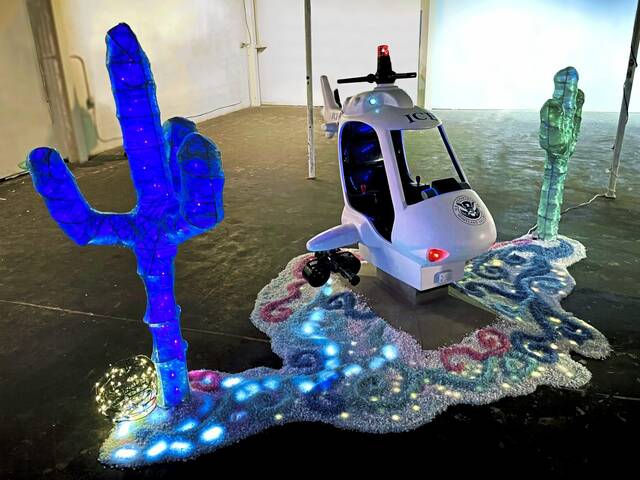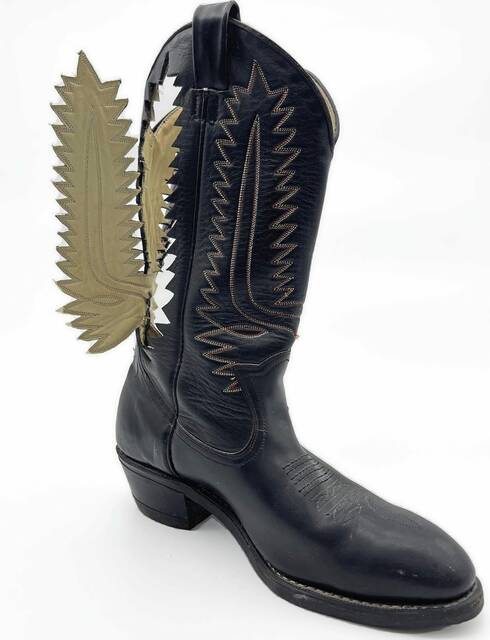Texas artists explore weaponization of border in Pittsburgh exhibition
These days, when the word “border” is spoken, it’s often about the line separating the United States from Mexico.
“The Border is a Weapon/La Frontera es un Arma” a special exhibition of artwork from and about the U.S./Mexico border, currently showing in Pittsburgh Cultural Trust’s downtown 937 Gallery, illuminates that issue — but it also invites viewers to consider a larger perspective.
“Borders are everywhere. Pittsburgh has its own bridges and walls that make life easier or harder for some people,” said Jennifer Myers, co-founder of Other Border Wall Project, a Pittsburgh-based art collective making creative resistance to borders. “We like to think about how borders aren’t just political lines, but how they divide us in other ways — even how the rivers of Pittsburgh become like borders.”
Curated by Laredo, Texas-based artist and educator Gil Rocha, “The Border is a Weapon” runs through April 10 in the Cultural District gallery. Presented by Other Border Wall Project, it features work by Maritza Bautista, Angel Cabrales, Juan de Dios Mora, Daniela Cavazos Madrigal and Jose Villalobos.
The artwork includes sculpture, installation, photography, video and works on paper, along with a sound component.
“Pittsburgh is filled with bridges and borders. The more I visit Pittsburgh, the more I see what we have in common,” Rocha said. “Yet, unlike the border, Pittsburgh also struggles with class and racial issues. The exhibition lays many of these common issues on the table … the border in many cases is just a step foot away.”
Growing up near the border, Rocha said, “I have been blessed to navigate between two cultures and have a deep appreciation for both. I understand that borders are very unique places where languages and cultures meet and, as an artist, it’s as if I get two plates to choose from: both plates filled with language, music, food, art and culture.”
In recent years, he said, he has seen ways the border has been politicized and weaponized as a way to divide people.
”It is so unfortunate that our beautiful border river Rio Grande is not something we can enjoy as when I was a kid,” he said. “If I get close to the river now, ‘Big Brother’ is always watching and it feels so wrong.”
Rocha previously visited Pittsburgh in 2019 to lead a community mural workshop. The resulting mural, “Disrespecting the Border/Irrespetando la frontera,” is currently displayed in the University of Pittsburgh’s Hillman Library.
Artists featured in the exhibition previously lived or currently live on the border of Laredo/Nuevo Laredo or El Paso/Ciudad Juarez.
“They each bring a different perspective about border issues,” Rocha said.
• Maritza Bautista works with photography and video, bringing into focus the aesthetics of “Casas de Cambio” (currency exchange houses) and how currency exchange impacts life at the border.
• Angel Cabrales’ sculptures highlight governmental and vigilance aspects of the border. Two works incorporate children’s rides, like those found outside grocery stores, with the rides made to mimic the vehicles used by Immigration and Customs Enforcement.
• Jose Villalobos’ works are about “machismo,” or aggressive and exaggerated masculinity, and issues facing the LGBTQ community.
• Daniela Cavazos Madrigal works with fabric and recycled garments. One of her pieces brings attention to the mistreatment and disappearance of women along the border.
• Juan de Dios Mora presents a series of detailed linocut prints that highlight the journey of crossing the border.
“I have fond memories of those (grocery store) riding toys,” said Scott Schiller, Pittsburgh Cultural Trust vice president of artistic planning. “To see the artist take that nostalgic image that inspires fond memories and then assert a new kind of violence on top of it — taking a helicopter toy and turning it into a border patrol helicopter with guns on the wings — subverted my expectations and challenged my idea of the insular society I grew up in, and how different my childhood experiences were to childhood experiences many immigrant populations face today.”
Schiller said the presentation of “The Border is a Weapon” marks an important step in the evolution of the Trust’s visual arts programming, which began in 1992.
“The Trust programs six different galleries throughout the Cultural District, and the gallery at 937 Liberty Ave. has been taking on increasing importance in the gallery portfolio over the past five years,” he said. “It’s an exciting space to see work, and the programming team working with a diverse group of curators really have begun thinking about that space as a place to deepen storytelling around issues of national importance.”
Myers founded Other Border Wall Project “without really meaning to” with fellow Pittsburgh artists Tereneh Idia and Leah Patgorski, in response to the Trump administration’s proposed border wall.
“The Trump administration posted an open call for people to submit design ideas for the border wall and other border wall projects,” Myers said. “I just felt like, as artists, we had to respond with our own anti-wall and humanitarian designs, knowing full well that they would be rejected.
“We submitted six anti-wall designs and somehow, amazingly, the press caught wind of it, and the designs ended up being shared across news platforms in early April 2017,” she said. “That really blew our minds and we decided we should just keep doing the work however we could.”
“The Border is a Weapon” is supported by The Opportunity Fund, The McKinney Charitable Trust, the A.W. Mellon Educational and Charitable Trust Fund of the Pittsburgh Foundation and individual donors.
Gallery hours are 11 a.m.-6 p.m. Wednesdays-Thursdays, 11 a.m.-8 p.m. Fridays-Saturdays and 11 a.m.-5 p.m. Sundays. Admission is free.
For information, visit trustarts.org.
Shirley McMarlin is a Tribune-Review staff writer. You can contact Shirley by email at smcmarlin@triblive.com or via Twitter .
Remove the ads from your TribLIVE reading experience but still support the journalists who create the content with TribLIVE Ad-Free.


